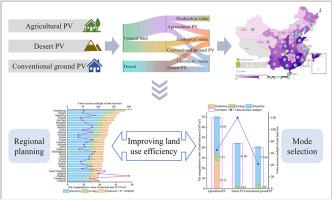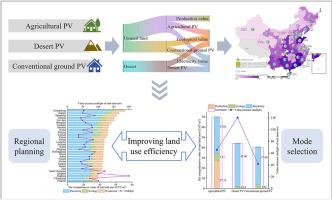Booming solar energy drives land value enhancement: Evidence from 648 photovoltaic projects in China
IF 9.7
1区 环境科学与生态学
Q1 ENGINEERING, ENVIRONMENTAL
引用次数: 0
Abstract
Land use of photovoltaic (PV) facilities has always been a pressing research field, as the transition to renewable energy requires balancing between land productivity and energy generation. A comprehensive assessment of PV land use benefits is crucial for informed deployment decisions. Here, we propose a multidimensional land use analysis framework, focusing on power generation, production, ecology, and their co-benefits, aiming to assess the impact of PV applications on land use and to quantify the ensuing changes in land value. The results show that PV deployment significantly increases land values. Specifically, the power generation value of PV land in China ranges from 1.90 × 105 to 5.09 × 105CNY/hm2; the production value brought by agricultural development ranges from 6.28 × 104 to 1.53 × 105CNY/hm2, and the value of ecosystem services provided by the land ranges from 2.43 × 104 to 8.95 × 104CNY/hm2. From a power station type perspective, the development potential for agricultural PV systems in optimizing layout and flexible use is infinite. This system can create tremendous increments in land value. Building desert-based PV plants provides the highest appreciation multiple for arid areas’ land resources while bringing sustainable economic and ecological prosperity. This study contributes to a better understanding of the current impact of PV deployment on land resources, and helps policymakers and stakeholders find intrinsic linkages between energy and the economy, ecology, and the environment, thus guiding and steering a more sustainable development of renewable energy planning and land use optimization in China.


蓬勃发展的太阳能推动土地价值提升:来自中国 648 个光伏项目的证据
光伏(PV)设施的土地利用一直是一个紧迫的研究领域,因为向可再生能源过渡需要在土地生产力和能源生产之间取得平衡。全面评估光伏设施的土地利用效益对于做出明智的部署决策至关重要。在此,我们提出了一个多维土地利用分析框架,重点关注发电、生产、生态及其共同效益,旨在评估光伏应用对土地利用的影响,并量化随之而来的土地价值变化。结果表明,光伏发电的应用大大提高了土地价值。具体而言,中国光伏用地的发电价值从 1.90×105 到 5.09×105CNY/hm2 不等;农业发展带来的生产价值从 6.28×104 到 1.53×105CNY/hm2 不等;土地提供的生态系统服务价值从 2.43×104 到 8.95×104CNY/hm2 不等。从电站类型的角度来看,农业光伏系统在优化布局和灵活使用方面的发展潜力是无限的。该系统可创造巨大的土地增值。建设荒漠光伏电站可为干旱地区的土地资源提供最高的增值倍数,同时带来可持续的经济和生态繁荣。本研究有助于更好地理解当前光伏发电对土地资源的影响,帮助政策制定者和利益相关者找到能源与经济、生态和环境之间的内在联系,从而指导和引导中国可再生能源规划和土地利用优化的可持续发展。
本文章由计算机程序翻译,如有差异,请以英文原文为准。
求助全文
约1分钟内获得全文
求助全文
来源期刊

Journal of Cleaner Production
环境科学-工程:环境
CiteScore
20.40
自引率
9.00%
发文量
4720
审稿时长
111 days
期刊介绍:
The Journal of Cleaner Production is an international, transdisciplinary journal that addresses and discusses theoretical and practical Cleaner Production, Environmental, and Sustainability issues. It aims to help societies become more sustainable by focusing on the concept of 'Cleaner Production', which aims at preventing waste production and increasing efficiencies in energy, water, resources, and human capital use. The journal serves as a platform for corporations, governments, education institutions, regions, and societies to engage in discussions and research related to Cleaner Production, environmental, and sustainability practices.
 求助内容:
求助内容: 应助结果提醒方式:
应助结果提醒方式:


